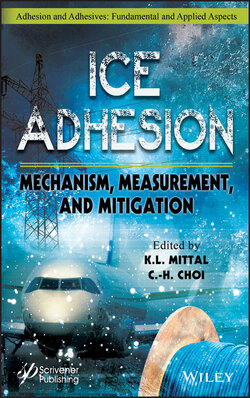Читать книгу Ice Adhesion - Группа авторов - Страница 12
1.1 A Brief History of Man and Ice 1.1.1 Ice on Earth
ОглавлениеPlanet Earth is in a constant, albeit slowly, changing state. In the 4.5 billion years since its formation, the climate of Earth has gone through many fluctuations in which there have been periods of more or less ice accumulation. Upon formation, during the Hadean Eon, young planet Earth was completely molten and had frequent collisions with other bodies in the primordial solar system [1]. Many of these colliding bodies were “planetary embryos” which were carriers of water, thought to have originated from the outer asteroid belt [2]. The accumulation of water around the molten blob that was Earth allowed for cooling to occur and a solid crust to form approximately 4.4 billion years ago. One of the collisions with another celestial body caused the formation of the Moon, and in the same process created Earth’s early CO2- and water vapour-rich atmosphere. The high pressure of this young atmosphere allowed for the first time liquid water oceans to exist on Earth, despite the estimated surface temperature of 230°C [3].
Single-cellular life emerged in Earth’s oceans approximately 4 billion years ago, marking the start of the Archean Eon [4]. Oceanic cyanobacteria, the first single-celled organisms capable of photosynthesis, appeared approximately 3.5 billion years ago and started producing oxygen as a waste product. The oxygen produced through photosynthesis was readily captured chemically by dissolved iron until approximately 2.4 billion years ago when these oxygen stores became filled, at which point atmospheric oxygen appeared for the first time [5]. This Eon, known as the Proterozoic, also saw volcanic activity diminish which lessened the levels of atmospheric CO2. The lowered CO2 and increased O2 concentrations resulted in a weakened greenhouse effect, leading to the Huronian glaciation [6]. This marks the first time that water existed as a solid on Earth. The approximately 300 million year long event was severe, with the entire planet being frozen over in what has been termed “snowball Earth”. The Huronian Ice Age was one of the main contributing factors to planet Earth’s first mass extinction [6, 7].
Earth’s temperature rebounded approximately 2.1 billion years ago, allowing for the first Eukaryotic cells to form. This was followed by the emergence of multicellular organisms approximately 1.6 billion years ago [8]. As multicellular organisms began to grow larger, and more complex, their death (and subsequent sinking to the seabed) is hypothesized to have served as a sequestration of CO2 [9, 10]. The sequestration of CO2 caused the onset of the Cryogenian period 720 million years ago, a period which included the longest known ice ages: the Sturtian and Marinoan glaciations [11]. The post-Cryogenian Earth has seen the evolution of Molluscs and Anthropods, in what has become known as the Cambrian Explosion due to the gigantic number and diversity of the forms of life introduced [12, 13]. The Andean-Saharan glaciation marked the next major extinction event on Earth, approximately 450 million years ago and lasted about 30 million years [14]. The end of the Andean-Saharan ice age ushered in the evolution of the first Tetrapoda, Earth’s first land animals as well as an explosion in the number of land plants [15, 16]. The huge number of land plants greatly increased the level of atmospheric oxygen, and decreased the level of atmospheric CO2, leading to another period of a weakened greenhouse effect. Thus started the Late Paleozoic Ice Age approximately 360 million years ago which would last approximately 100 million years [17].
The rebound in global temperatures following the end of the Late Paleozoic Ice Age saw the introduction of large land animals, most notably the Dinosaurs in the late Triassic period approximately 240 million years ago [18]. Following the extinction of the Dinosaurs about 66 million years ago, mammals, birds and flowers evolved, again affecting the level of atmospheric CO2. The decreased greenhouse effect of the present time started approximately 2.6 million years ago, leading to what is called the Quaternary (or Current) Ice Age [19]. Periodic changes in the Earth’s orbit around the sun during this glaciation has resulted in characteristic interglacial (or warm) events [20]. The latest such retreat of the ice sheets 12000 years ago has been called the Holocene Epoch, and has allowed humans to inhabit northern latitudes [21].
